Email subscribers are valuable. We work hard to get them and hard to keep them. But no matter how perfect your marketing is, you’re going to lose some subscribers along the way and you just may struggle with understanding why people unsubscribe from your email campaigns.
The question is, how can you minimize those losses?
New email marketers often get a surprise when they realize their list growth efforts aren’t resulting in a larger list. How could that be? They’re getting new subscribers every day.
Well, the list growth gets counteracted because of something called “list churn”. That not-so-nice sounding word refers to how many subscribers fall off your list every year. They can fall off due to
- hard bounces
- because someone changed jobs
- because you removed them for better list hygiene
- because they unsubscribed
Some sources estimate that list churn can erode up to 32% of a list each year. It takes a lot of list building to stay ahead of losses like that.
That may be why list churn is not talked about much. It’s not a glamorous subject. For some marketers – the ones who minimize unsubscribes – it’s not too big of a problem. They can build their lists fast enough to stay ahead of the list churn effect.
Other marketers struggle. Even though they may grow their list by, say, 5% every month, they’re losing almost that many subscribers every month, too. So if one of these marketers was adding 5% new subscribers every month, but also losing 4% of their old subscribers every month, they’d end up with just 1% of list growth.
Ouch.
While this sounds really bad, there is a positive side to it. According to Return Path, an email marketer with a list of one million subscribers could save $400,000 just by reducing list churn .05%.
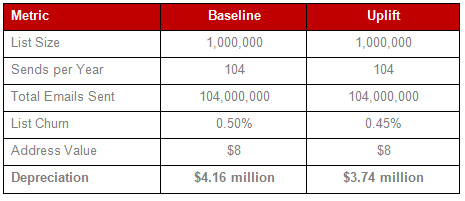
There’s more good news. It appears most email marketers are ahead of the list churn curve. That’s what Ascend2 learned from a survey they did earlier this year for their report, Email List Growth. Here’s how quickly marketers say their lists are growing:
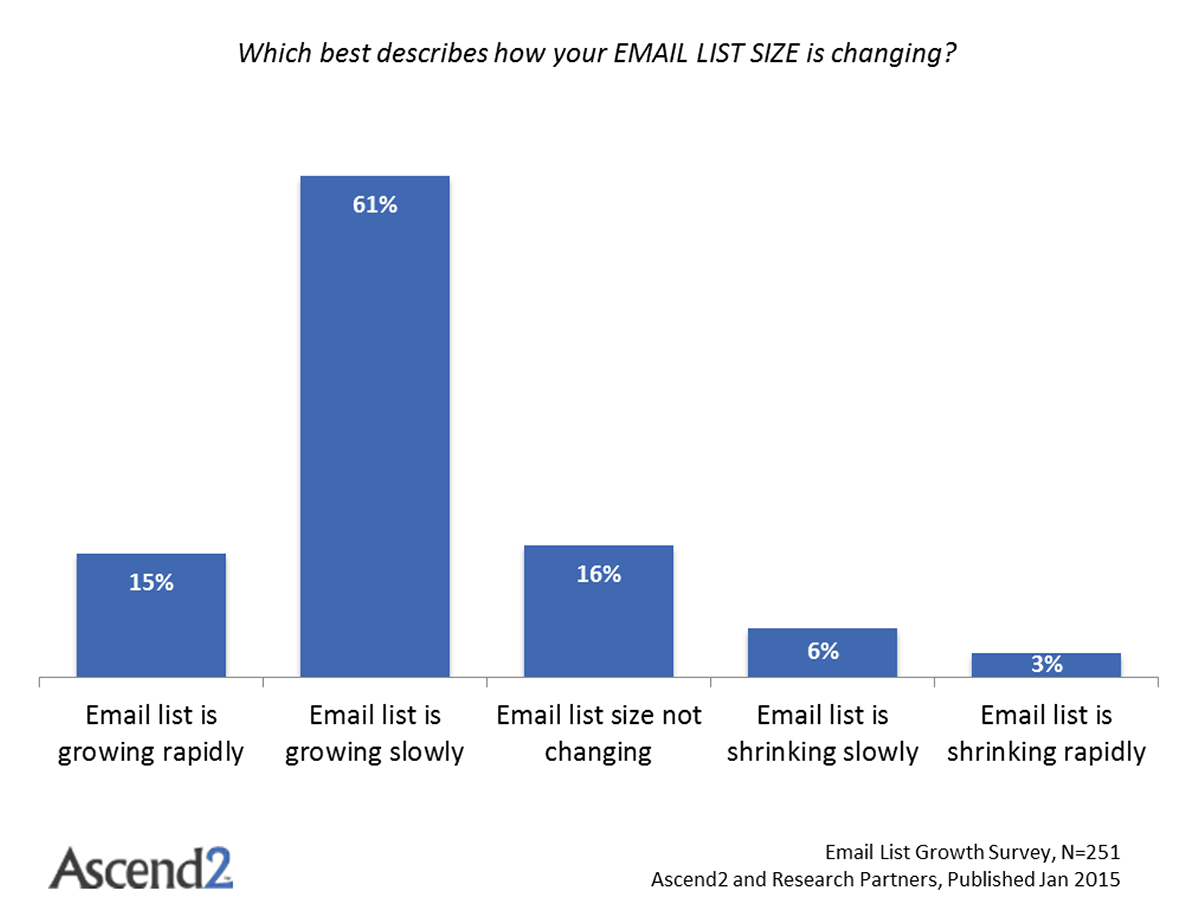
What you can and can’t control in list churn
There’s a lot about list churn we can’t do anything about. People are always going to leave email accounts. There’s always going to be some subscribers who never engage, even enough to open a welcome email. But the subscribers who on the fence – the people who are thinking about unsubscribing – we can do something about.
The “emotionally unsubscribed”
There are two types of people who unsubscribe: Those who actually go through with the manual unsubscribe process, and those who just disengage. The disengaged ones are often called the “emotionally unsubscribed.” They just kind of drift away.
In a crowded inbox, out of sight is out of mind
As the emotionally disengaged stop opening and clicking on our emails, their spam filter software starts moving our emails to their bulk folder. They don’t even see our emails anymore.
Or maybe they want to read our emails, but don’t have time. So they create a filter and send the emails to a special folder. This is better than the emails going to spam, but not much. They don’t read or even see our emails anymore.
There’s yet another possibility. They may still be getting our emails in their inbox, but the emails are going to a secondary or tertiary email account. These non-primary email accounts don’t get checked every day. They’re probably prime candidates for becoming the kind of email accounts that get abandoned. We don’t even know it’s happened until we see the hard bounce.
How to manage the emotionally unsubscribed
Once a subscriber has fallen into disengagement, it takes a lot to get them back. You can try a re-engagement campaign, but you’ll be very lucky if you get even 20% of them back. Typically, they end up getting removed by the email marketer when it comes time to clean up the list.
It’s better to improve your practices before they become disengaged. That can mean applying some segmentation. It might mean testing dynamic content in email marketing, or adding more valuable content to the email. Basically, it just means making better emails.
How to manage unsubscribes – the key to understanding why people unsubscribe
In some ways, we can do more for the people who actively unsubscribe than we can do for those that just drift away. The first thing to do is to figure out why people unsubscribe. It could be because
- we sent emails too often
- we sent emails too infrequently
- we sent emails that were overly promotional
- we sent emails that weren’t relevant to them
- we sent emails that weren’t useful
- they just stopped checking the email account they signed up with
- we sent emails that didn’t look good on mobile devices, or that were basically unreadable and unclickable on mobile devices
- Many of those reasons are the same things that cause the emotionally unsubscribed to drift off. But in the case of active unsubscribers, the offenses are either rank enough, or they are proactive enough to actually do something about those messages we keep sending.
You sent them emails too often
The number one reason people unsubscribe is because they’re getting too many emails.
So what’s too many? And what’s the ideal mailing frequency? Honestly, it depends on your list, the quality of your emails and each individual subscriber. But here’s what MarketingSherpa learned when they asked over 2,000 US adults, “How often, if ever, would you like to receive promotional emails (e.g., coupons, sales notifications) from companies that you do business with?”
I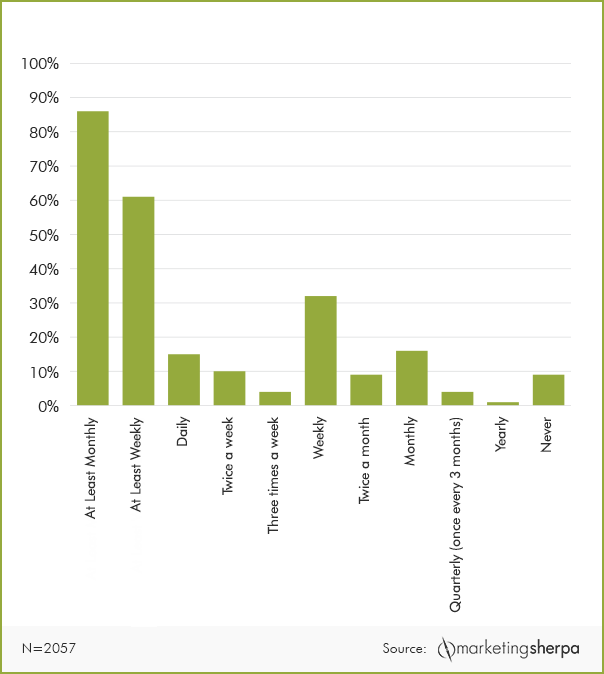
The answers are a bit spread out, but 60% said “at least weekly”. Another 30% said “weekly”. And given that weekly emails are pretty standard practice for most email marketers, you could make an argument that weekly is a good frequency, but any more than that is “too often”.
You can send less often, of course. Once a month is the lowest frequency most email marketing sources recommend. Any less than that and there’s a risk your subscribers just won’t remember you, and thus will cull your email as soon as it hits their inbox. Some studies have supported sending emails every two weeks. That’s right between monthly and weekly, of course, so it could be a happy medium. Again, it all depends on the list.
Test your mailing frequency
While it’s always good to ask your subscribers what they want, but sometimes it’s easier – and even better – to just use their behavior to determine what they want. One example of this for unsubscribes is to skip the sending frequency preferences altogether. Just test them.
These mailing frequency tests can be very interesting. Usually, the more frequently you mail, the lower your engagement rates will fall. But don’t look only at engagement rates – also look at the most important metric you’ve got. That’s typically earnings per email sent.
Here’s an example:
You’ve been mailing once a week. You get an open rate of 15%, click-through rate of 5%, and an earnings per email of 50 cents.
You switch to sending emails every two weeks. Your open rate goes up to 20%. Your click-through rate rises to 7%. You earn 60 cents per email. You also save some staff time because you’re making and sending and analyzing fewer emails.
However, you just took a chunk out of your email revenue. To have made up for the email campaign you didn’t send, you needed to earn $1.00 per email. Instead, you’re 40 cents short. Your boss has seen enough of this test – you’re back to mailing weekly.
Another common scenario is you mail more often (especially around the holidays) and as a result your engagement metrics go down. Even your earnings per email go down. But because you’re sending twice as much email, even though you’re earning less per email, you’re earning more overall. Email revenues are up. Your boss tells you to keep sending, while you worry about when people are going to start unsubscribing.
Some marketers welcome unsubscribes
Some marketing experts aren’t phased by unsubscribes. They actually encourage people to unsubscribe. They’ll send a targeted email to people who haven’t opened or clicked in a while. Here’s an example of one of those emails:
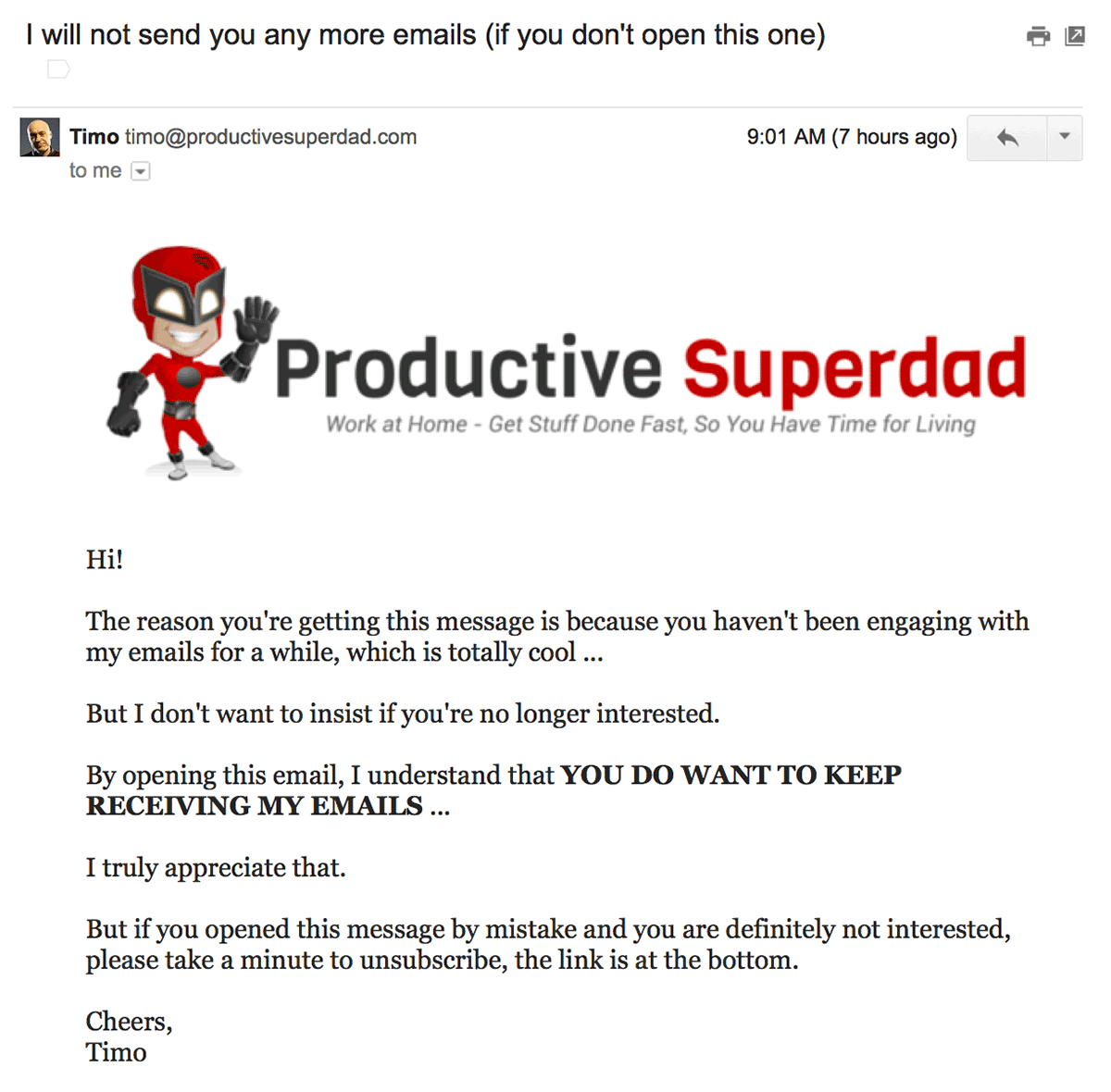
Copyblogger took this perspective and went so far as to write a whole post about why unsubscribes are good for business. They definitely fall into the quality side of the quantity-versus-quality debate, but it’s worth a read if you want to feel better about a smaller list. It might give you some courage to clean up your list, too.
How to convince them to stay
The best way to keep subscribers is to give them a way to control how often they hear from you. This is basically inserting a preference center into your unsubscribe process. It might look like this:
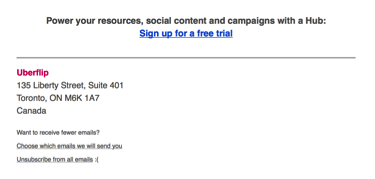
Or you could include a prompt in the body or postscript of your email, like this:
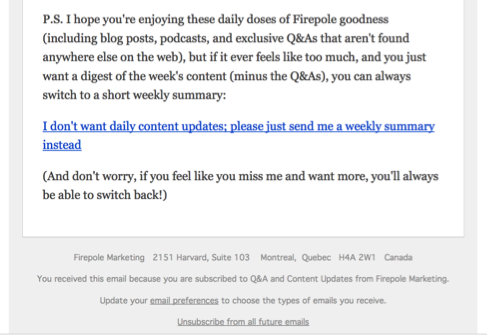
This is often referred to as letting people “opt-down”. If you mail more than once a week, it might be worth a try.
Just don’t go too crazy with offering different sending frequencies – you are going to have to create a new email for each frequency. So if you’ve been emailing more than once a week, offer them a way to downgrade to one a week or every other week.
New idea: Practice reverse segmenting
You probably know that segmenting means emailing different email messages to different portions of your list. And you probably know it’s one of the best ways to improve engagement, and to reduce unsubscribes.
But when most of us think of segmentation, we think of doing it at the front-end: in the opt-in box. Or maybe via “progressive profiling”, where you learn about new subscribers based on information you ask them over time. So instead of a long survey about their information and what they’re interested in, you basically ask them for one tidbit of information at a time, progressively learning more about them as you go.
But it’s also possible to segment according to what people don’t want to know about. Check out this email from marketing guru Dany Inny. In the bottom of the email, he asks people if they don’t want any information about publishing a book. Anyone who clicks that link won’t get any more emails on that topic. Interesting, eh?
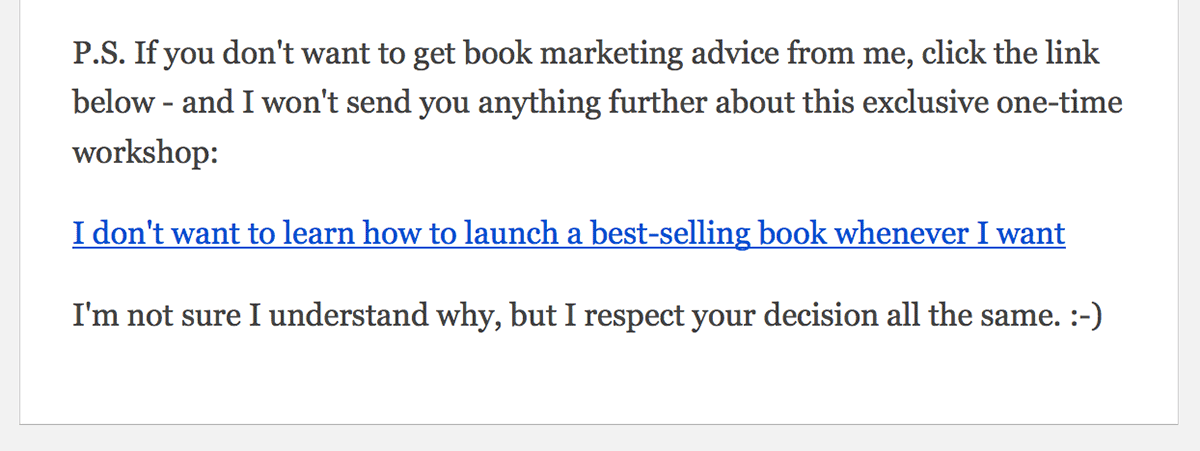
If they still decide to leave, make the most of it
Even with world-class content, complete control of sending frequency, and laser-targeted segments, some people are always going to want to unsubscribe. So long as your unsubscribes are below .5%, you’re doing well. So long as they’re under 1%, you’re doing okay.
Here’s how to still benefit from unsubscribes, and maybe even convert some of them to another channel.
1) Use an exit survey.
Exit surveys are very popular right now. They’re a great way to find out more about why people are leaving.
Here are two examples of email exit surveys:
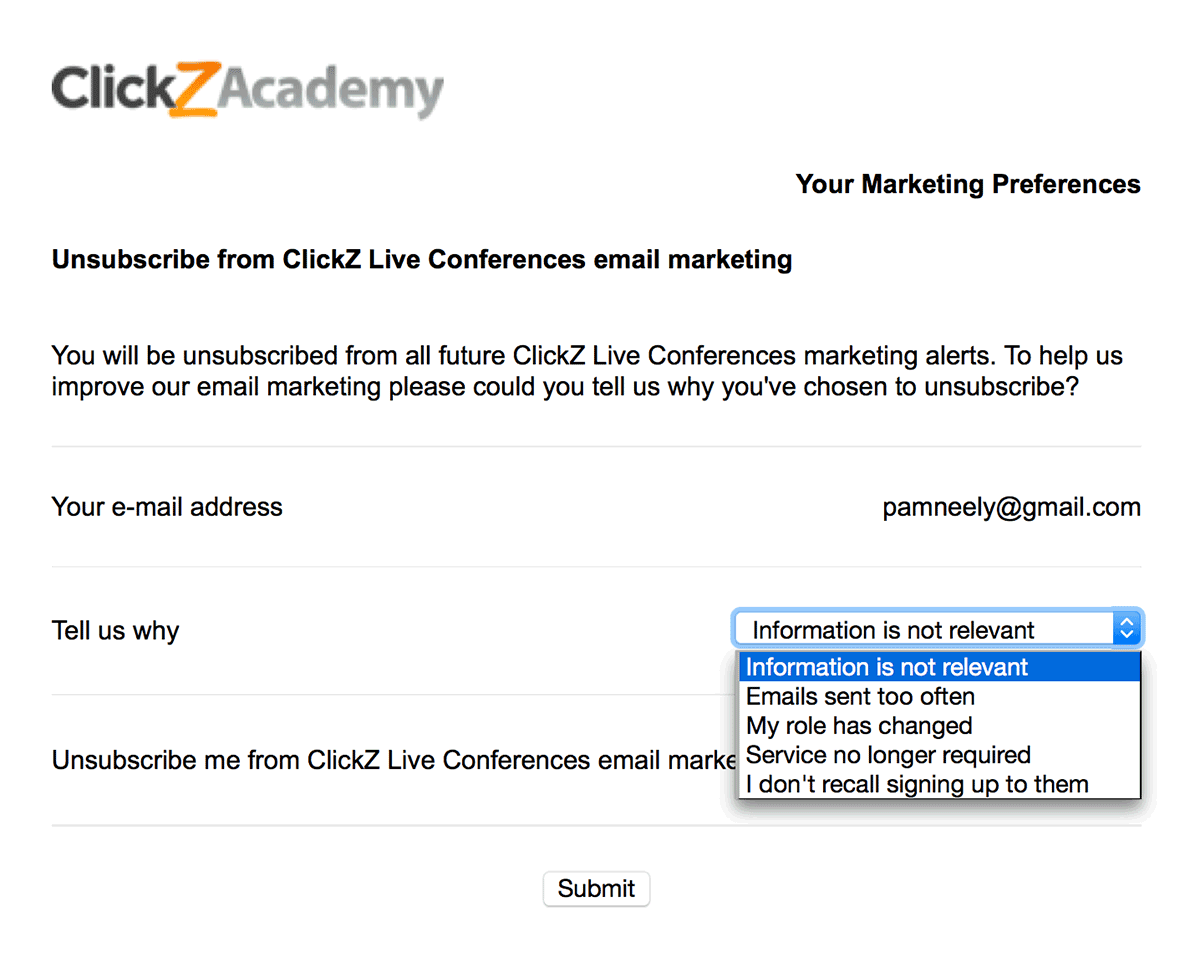
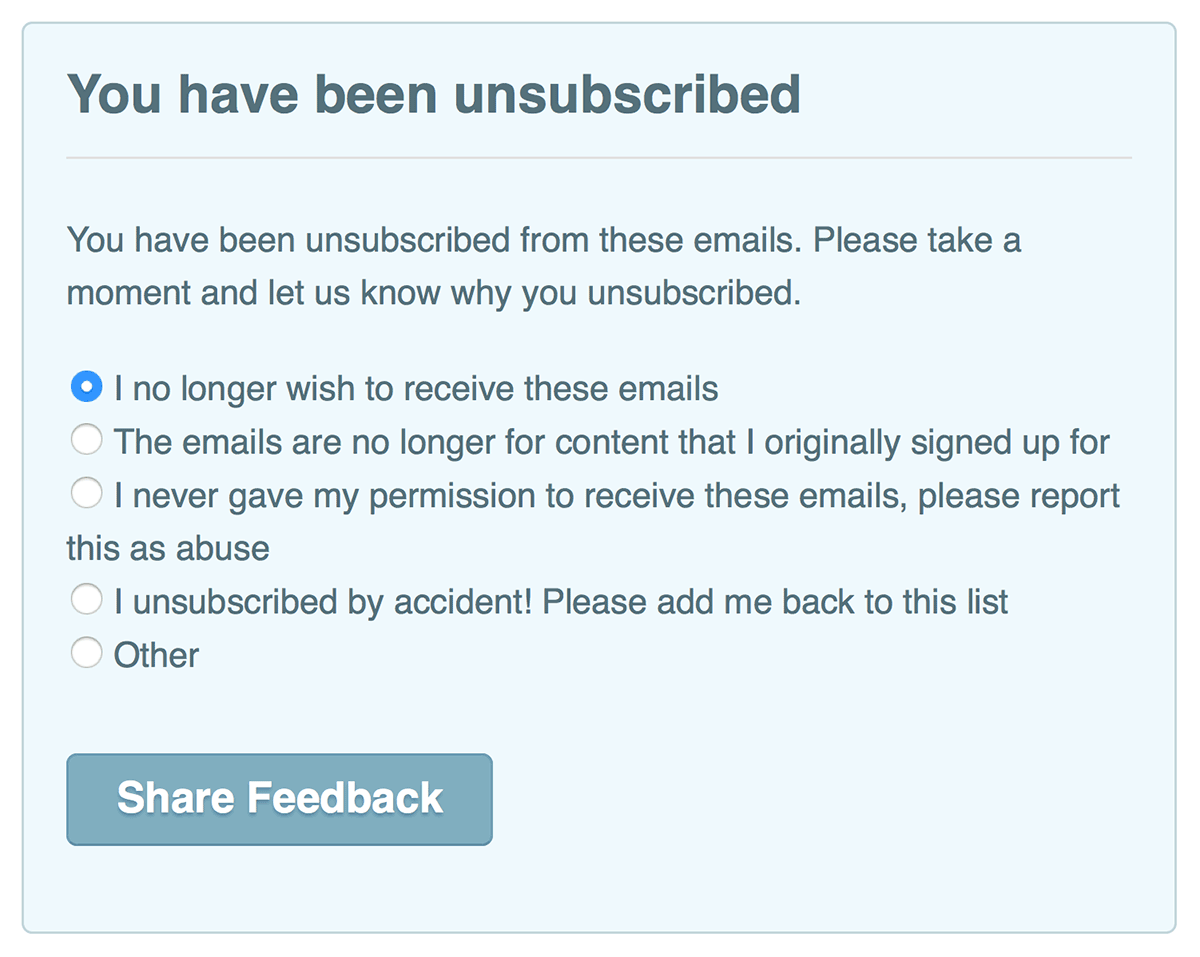
2) See if they’d like to follow you on social media instead.
Sometimes we just want to clear out our inboxes. It doesn’t necessarily mean we don’t want to hear from the sender ever again. So include linked icons to your major social media accounts on the final unsubscribe page. You may be able to just shift people to a different channel for awhile.
Here’s how the B2B firm DNN Corp asks people who have just unsubscribed if they’d like to follow the company on social media instead:
![]()
3) Make it easy for them to go.
Don’t ever make it a hassle for subscribers to unsubscribe. Don’t:
-
Take any more than a few hours to remove them from your list.
Once in awhile you’ll see some really poorly managed list send you an unsubscribe confirmation that says you’ll be removed from the list in 5-7 days. This is infuriating. Don’t drag your feet with unsubscribes. The whole process is digital – there’s no reason unsubscribes can’t be processed instantly. And yes, Pinpointe always has and always will process unsubscribes instantly.
-
Send them an email notifying them that they’ve been unsubscribed.
Some marketers say this is a good thing to do. I’m in the camp that believes it’s not, but maybe I’m wrong. It’s tedious to go through the process of unsubscribing only to get yet one more message announcing “You’ve been unsubscribed!” The message on the unsubscribe confirmation page was enough.
How to handle the unsubscribe process in your Pinpointe account
Last year we rehauled how the Pinpointe system handles unsubscribes. It means more flexibility for you and a better experience for your subscribers. This video will walk you through the highlights of the changes.
Conclusion
You’ll never be able to stop all unsubscribes. But by applying some of the techniques mentioned above, you can minimize them. Even a 20% reduction in email unsubscribes could make a big difference in your list growth efforts. It should also result in happier, more engaged subscribers.






